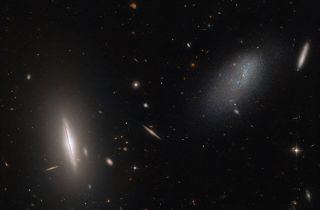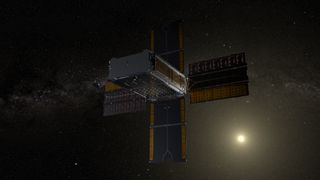
Doris Elin Urrutia
Doris is a science journalist and Space.com contributor. She received a B.A. in Sociology and Communications at Fordham University in New York City. Her first work was published in collaboration with London Mining Network, where her love of science writing was born. Her passion for astronomy started as a kid when she helped her sister build a model solar system in the Bronx. She got her first shot at astronomy writing as a Space.com editorial intern and continues to write about all things cosmic for the website. Doris has also written about microscopic plant life for Scientific American’s website and about whale calls for their print magazine. She has also written about ancient humans for Inverse, with stories ranging from how to recreate Pompeii’s cuisine to how to map the Polynesian expansion through genomics. She currently shares her home with two rabbits. Follow her on twitter at @salazar_elin.
Latest articles by Doris Elin Urrutia

Astronomical Unit: How far away is the sun?
By Rebecca Sohn, Doris Elin Urrutia last updated
Reference Earth's distance from the sun averages about 93 million miles (150 million km), which scientists also call one astronomical unit (1 AU).

How fast is Earth moving?
By Elizabeth Howell, Doris Elin Urrutia last updated
Earth moves around the sun and across the universe on its axis and at an incredible rate.

What is the temperature on the moon?
By Tim Sharp, Doris Elin Urrutia last updated
Reference We explore what the temperature is on the moon and see why it varies so considerably.

Hubble Space Telescope peers into a glittering sea of extragalactic stars (photo)
By Doris Elin Urrutia published
A new Hubble Space Telescope image highlights a region in the dwarf satellite galaxy the Large Magellanic Cloud that is rich in stars.

Hubble Space Telescope spies odd pair of galaxies near Big Dipper (photo)
By Doris Elin Urrutia published
A new image from the Hubble Space Telescope proves that astronomers don't have to look very far to find something astonishing.

Hubble Space Telescope reveals a stunning star cluster (photo)
By Doris Elin Urrutia published
Hubble snapped a great shot of NGC 376, a loose gathering of stars located outside our Milky Way, in a dwarf galaxy called the Small Magellanic Cloud.

Faraway blue star cluster shines in Hubble Space Telescope photo
By Doris Elin Urrutia published
Stars can come in an array of shapes, sizes, ages and colors. But in the case of NGC 2031, the context doesn't quite match the colors.

Meet the 10 asteroids NASA's Lucy spacecraft will visit
By Doris Elin Urrutia last updated
The Lucy mission launched on Oct. 16, 2021, to study the unique Trojan asteroids, which orbit ahead of and behind the planet Jupiter.

NASA scientist explains why Venus is Earth's 'evil twin' (video)
By Doris Elin Urrutia published
Scientists and engineers from NASA and the European Space Agency want to know a whole lot more about why Venus resembles Earth in so many ways, and yet is so strikingly different.

The top space stories of the week!
By Doris Elin Urrutia last updated
These are some of this week's top stories.

Space photos: The most amazing images this week!
By Doris Elin Urrutia last updated
The Wolf Moon enchants people across the world, a comet visits Earth for the first time since the Stone Age and a Snoopy toy exits the NASA Artemis 1 Orion spacecraft. These are some of this week's top photos.

Space board game deals 2023: Cosmic encounters on the tabletop
By Jordan Middler last updated
Deals In space, no one can hear you scream at your friends. Here are the top space board game deals out there right now.

Track NASA's space radiation experiment BioSentinel as it flies around the sun
By Doris Elin Urrutia published
Now you can follow NASA's BioSentinel cubesat as it flies through space. The experiment will investigate the effects of cosmic radiation on cells.

Hubble Space Telescope delivers holiday sparkle in new image
By Doris Elin Urrutia published
A new Hubble Space Telescope image displays the quintessential colors of the holiday season: bright blue-white stars shine against dusty swaths shaded red.

Stunning SpaceX rocket launch lights up predawn sky over Florida (photos)
By Doris Elin Urrutia published
A SpaceX Falcon 9 rocket produced a vibrant show when it launched in the pre-dawn sky from Florida, at 4:34 a.m. EST (0934 GMT) from Cape Canaveral Space Force Station on Dec. 28.

NASA's new X-59 supersonic plane gets powerful engine for quiet sonic booms
By Doris Elin Urrutia published
NASA's supersonic X-59 plane is now one step closer to its flight demonstration over U.S. communities now that it has its 13-foot engine for quiet sonic booms.

Stars young and old glitter with 'nebulosity' in Hubble telescope photos
By Doris Elin Urrutia published
Each of these Hubble Space Telescope images is a unique spectacle, and feature different colors that highlight various pieces of invisible information.

See Earth from space in stunning video from China's Tiangong space station
By Doris Elin Urrutia published
Earth displays its characteristic blue color as China's completed Tiangong space station, adrift high above the planet, appears in the foreground.

Hubble Space Telescope spies young stars amid glowing interstellar gas
By Doris Elin Urrutia published
In a new Hubble Space Telescope image, the color blue tells a story of young stars.

Winter on Mars looks beautiful in this festive NASA video
By Doris Elin Urrutia published
NASA is making the case for a "winter wonderland" on Mars in a new video from the Jet Propulsion Laboratory in California.

This scorching 'super-Earth' exoplanet is one of the most massive ever discovered
By Doris Elin Urrutia published
The newly-discovered planet is coated in molten magma, has a "year" that lasts half a day, and boasts gravity three times stronger than Earth's.

How far is the moon from Earth?
By Doris Elin Urrutia, Tim Sharp last updated
Reference Answering the question "how far is the moon from Earth?", can change depending on when you ask it. The average distance between Earth and the moon is about 238,855 miles (384,400 kilometers).

Newborn twin stars blast out jets of rainbow-colored gas in new Hubble image
By Doris Elin Urrutia last updated
Two puffs of star-making material exude mystical glows in a recently-published Hubble Space Telescope image.

